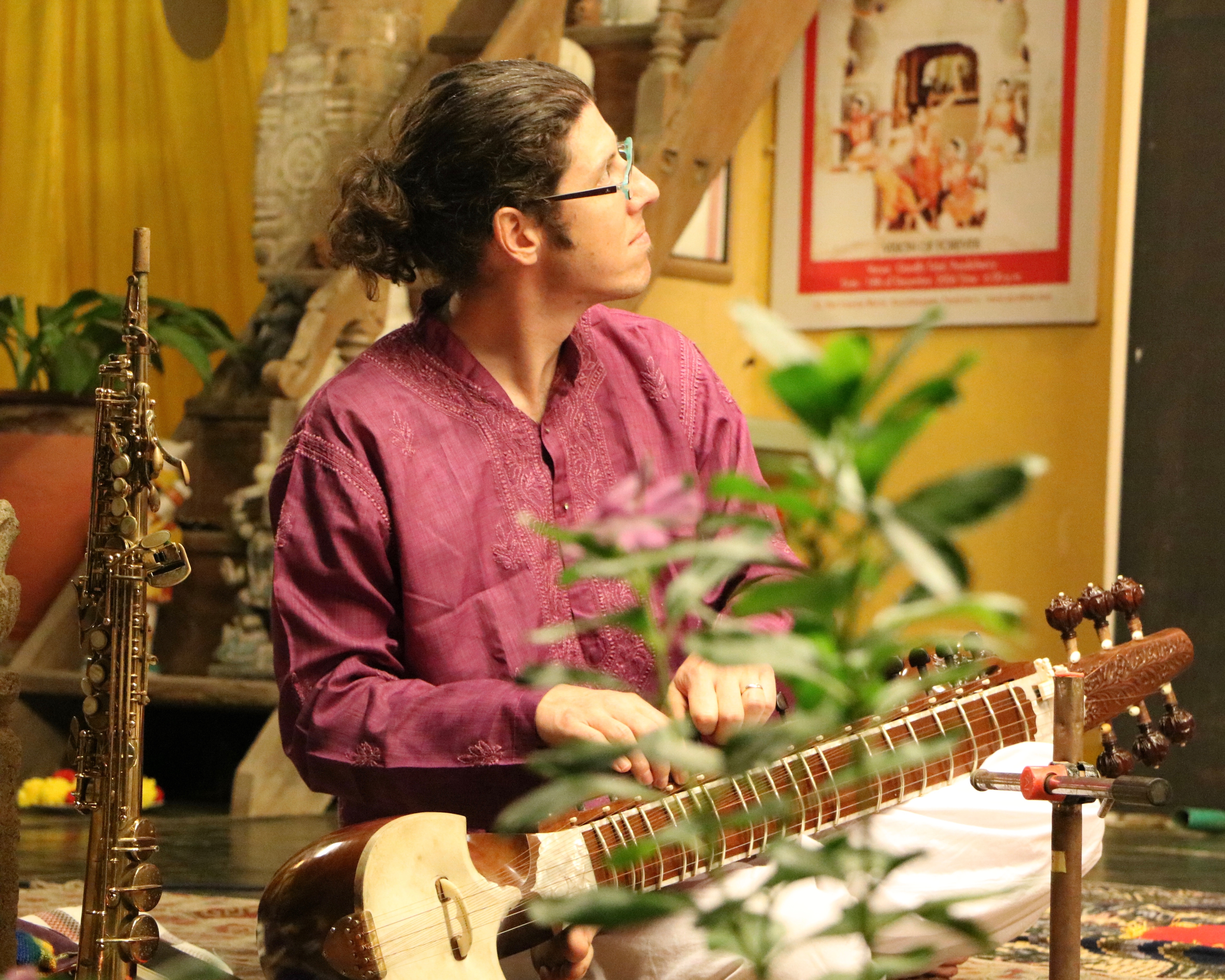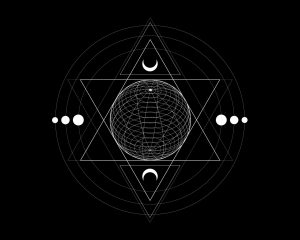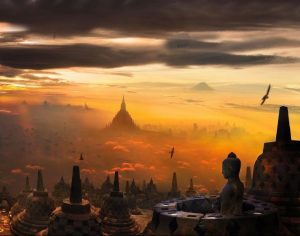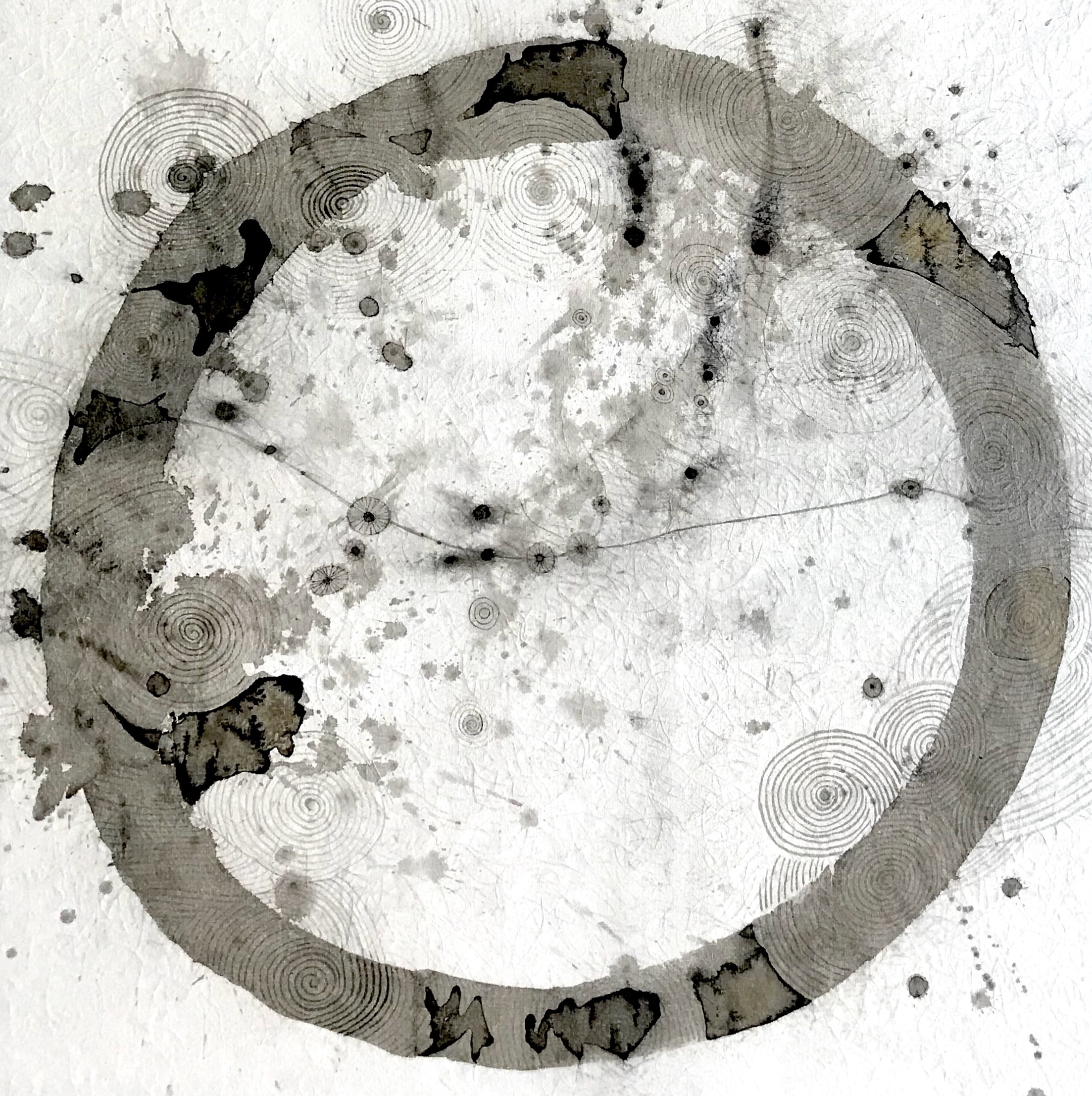
Sonic Mandalas of Becoming: an experimental sono-poetic arts-based inquiry
By: Jonathan Kay, PhD Student,
East-West Psychology Department,
California Institute of Integral Studies
original cover artwork buy Fumiyo Yoshikawa
Prelude
mandala #1 – arrival
the quiet hum of a far off highway
a brisk breeze gently rattling thin windows.
birdsongs of new friends
A new sonic terrain excited and stimulated me as I lay awake on the hard floor of my new apartment in Lower Haight, San Francisco. Anticipation of a new world opening before me;
new place, space, a new home to be cultivated;
new people, new stories, knew adventures to be had;
new sounds, songs, frequencies, tonalities to be discovered.
I hadn’t even spent 12 hours in California and I was off, racing down Hwy 1 in awe of the roaring pacific ocean, heading towards the Introduction to EWP retreat.
mandala #2 – redwood elder
footsteps in moist soil branches in the breeze
the forest remind us… compels us…
towards nonhuman bandwidths
I stand face to face with a wise elder different in kind.
the red wood speaks in musical tongues,
subsonic rumbles and overtonal screeches
flash and rip though my body,
primordial sounds terrify and terrorize
as the horizon of sense fractures
into a luminous infinite.
Bowing in reverence
my forehead touching the cresting wave
of continuous wisdom presence.
Introduction
I entered graduate studies in the East-West Psychology Department at the California Institute of Integral Studies in San Francisco, California with an idea of how this program may enrich me, and how I could implement this into my professional life. Ultimately I was searching to reconcile two very different aspects of myself. One, as a born and raised Torontonain jazz saxophonist, the other, as a North Indian classical music raga musician. While living for a decade in Kolkata, India, learning raga music, I chose to assimilate into the holistic life of my Guru’s teachings, and becoming a part of his family was a culturally transformative experience. I grew to feel at home within these two drastically different cultural containers, but also had to live with the tension between them. They occupy very different socio-cultural and psycho-spiritual territories, and I started seeking better understand of how I could integrate them harmoniously them into my life. This is the central question of my life, as a spiritual seeker and artist. I find it poetic that I found a home in East-West Psychology, because I feel like I live and embody many central questions this department represents.
What follows is the journey of my experiences over the past two years in EWP. Each class presented different questions of becoming which challenged me as a thinker and artist. I took these questions and found how they posed problems based on my goals of becoming. Sometimes they challenged and exposed the assumptions of my goals of becoming, unearthing new ground (below/above/within). Folding in from the exterior, new subjectivities form new topologies based on the never ending ebb and flow of temporality. This dance/play of subjectivity form the problematic nature of individuation.
These poetics in sound and word are expressions of existential and problematic sites becoming. These sites are productive and are immanently embodied and artistically depicted throughout this paper.
This paper has five sections titled:
Sonic Ontology
Cosmologies of Sound
Music Presencing – Process Relational Aesthetics
Aesthetic Biospirituality
Contemporary Sonocultures
mandala # 3 – individuation as problematic
intentionality (composition/improvisation) + breath = (non)expression
problem + becoming = expression
The space/play between:
- being/becoming
- one/many
- past/present/future (actual/virtual)
- body/mind (breath/intention) + spirit
- meditation: static/active
- single point concentration/ train of thoughts
How can we harmonize or organize heterogeneous gradients of becoming? How can we understand the gravity of subjectivity, or selfness-in-the-world? How can we form a psychic gravity which grounds the orbits of our many drives and desires.
mandala #4 – questions of becoming
Ontology:
What is the ground of reality
Being or Becoming?
transcendent or immanent
Being and becoming
the being-of-becoming
being-in-becoming
self-other – interior/exterior
What are your questions of becoming?
——A plane of consistency—— situating problems of becoming——
Epistemology:
A metaphysical container is build to house these probemlatics as polarities
a praxis is designed to realize the goals of becoming
experimentally, one proceeds
Ontogenetic individuation:
the individual becoming cosmic, as the cosmic becomes individualized
Individuation —>—>—>—> Chaosmos <—<—<— <—Cosm
The Integrative Impulse
Dr. Debashish Banerji teaches an experimental yogic praxis which develops internal structures capable of harmonizing plurality through an integrative process of individuation. He has helped me see my cross-cultural experiences and disciplines as a yantra or mandala (symbolic geometric diagrams of universal power) which can be harmonized into an integral vehicle of self-transcendence. This ontogenetic drive is called the integrative impulse (January 12, 2018); an ascending evolution of consciousness through cosmic individuation. By developing a faculty beyond the limitations of the rational mind, we can hold the diversity of multiple ways of knowing, leading beyond the limits of historical socio-cultural signification. This can result in a more holistic illumination that is based on integrating even the most paradoxically disparate modes of becoming.
mandala # 5 – creative evolution
“A spiritual idea is a power,
but only when it is inwardly and outwardly creative.
Here we have to enlarge and deepen
the pragmatic principle that truth is what we create,
and in this sense first, that it is what we create within us,
in other words, what we become” – Sri Aurobindo
(Ghosh, 2003, pp. 262)
Mandalas of Becoming
This collection of sound-iloquies are based on problems of becoming. I have gleaned gems of wisdom from each class in EWP, and assembled them into an integral mandala of self-becoming. I have presented each gem as a problematic territory of transdisciplinary engagement to be thought of as a sound-world, in which words and sounds dance intuitively, creating new worlds, guiding new ways of becoming. Through creative act of intentionality and free-play, these poetic expressions are an attempt to present an integral way of knowing. In Francis Bacon: The Logic of Sensation (2002), Gilles Deleuze argues the true source of knowledge is not rational or mental, but a being of sensibility experienced through precognitive affective feeling. Let us be guided by this primordial being of sensibility.
mandala # 6 – mandala sound painting
A mandala spirals around
an (in)visible point at the centrem
warping one into
an embodied bound infinite.
The bindu represents the portal
beyond self-Self distinction,
radical identity of ONE.
Yet each sound node in the organic architectonic
also represents a bound infinite of variation,
in relation to a gravity of becoming,
multidimensionally becoming a fractal
kaleidoscope of infinities playing with Infinity.
My mandala is made of four directions/houses of sonic knowing, leading towards the cultivation of an integral ontology of sound.
SONIC ONTOLOGY
three ontogenetic rhythms:
• fractal cosmology of vibration (metaphysics)
• biospirituality as process-relational harmonic (aesthetics)
• creative utopic sound-world (creative performance)
mandala # 7 – yantra of becoming-sound
A yantra is an engine of cosmic power.
Nature’s mind-lattice
synthesizing disparate orders of becoming
constellations of resonant nodes
crystallizing as auto-poetic tone rows.
A dynamic architectonic machine,
or meditation idea-diagram
generating synchronous eternal events.
Time-crystals with sonic dimensionality.
Through the sentience of sound
natures aspires to exceed herself.
Towards a Sonic Ontology
mandala # 8 – becoming-sound
consciousness is nothing but vibration
waves
light
colour
sound.
Listen to the melody of your own becoming
the mode of your soul
and simply
sound.
Will to spatialize time
European enlightenment epistemology and humanism is based on the idea that human rationality is the highest measure of all things, and the ever-increasing overdeterminism of the rational function over time has ontologically shaped modernity accordingly. Heidegger has called this the “age of the world-image” (Heidegger, 2002), in which the rational mind fragments reailty by enframing them it into objectified finite sized bytes, resulting in the spatialization of time into a series of now-points. Therefore all that happens in-time, or duration, and across time-quanta are subjugated to a partial description of their reality without accounting for their natural ecology of becoming. Leading us to the brink of social and ecological disaster, the episteme of modernity can be articulated as the gathering of reality into a single flattened frame so as to order its contents at will for mechanical production and consumption (Banerji, 2017b, pp.9). These consequences have led to a metaphysical drive to spatialize time, ontologically privileging sight over the other senses (Spanos, 1992, pp. 6).
What are the costs of subordinating the other senses to sight? How can we reclaim other ontological ways of knowing?
mandala # 9 – organic inquiry
an estuary of organic nodes
folding infinitely into fateful entanglement
phylogenetic lines of evolution
disrupted
a leap across heterogeneous gradients
a dark precursor
We can challenge and reject the assumptions of modernity and aim to carve out a territory based on alternative modalities of becoming. From this independent and partially free space, we can imagine an alternative-modernity where we can reengage with transnational neoliberal capitalism and consumerism on our own terms. I propose an alternative model based on the cultivation of sonic ways of knowing. Hearing differently can make us see differently and can lead to a whole new world of possibilities, breaking the hegemonic patterns of the past. Through cultivating a sonic-oriented ontology, I believe it is possible to reclaim a autonomous sense of becoming, and develop an intuition of ecology, based on the organic and relational interdependence of all things.
mandala # 10 – assemblage theory
Unconscious submission to mindlessness
is to assemble flows of aimless desire.
eating propaganda and images of artiface,
conditioning and in-prisoning
within a perpetuating
system of self-consumption.
Conscious assemblage of oneself
is to redefine ones territory,
sounding individual freedom
and composing reality
in the key of unbounded subjectivity.
Deleuze defines the assemblage theory as:
i.) state of things
ii.) enunciation (style of expression/language)
iii.) territory and movements of deterritorialization
(Deleuze, 1996)
mandala # 11 – sonic animism
What was the role of sound in ancient cultures? How did they perceive sound? How did sound become music, and what would delineate difference between the two? Is it possible that the animistic experience of ancient indigenous peoples was possibly dominated by a sonic-ontology? This idea leads us to explore greater importance and meaning that sound and music may have had these cultures. It naturally follows to also question how sonic epistemology could also lead to a plurality of sound worlds, all with subjective and radically different experiences of time flow. The nature of subjectively lived time (as opposed to clock or mechanical time), as posited by Bergson (Deleuze, 1988), is radically plural and corresponds to co-existent multiplicities Bergson calls duration. Additionally, following the research of Husserl (1980), the father of phenomenology, time and sound/music are intimately correlated and it is fruitful to explore our experience of duration through the phenomenology of music. It is here that we find how sound may be a critical link into understanding possibilities of different sonic ontologies, and how cultivating the discipline of music would potentially give access to alternative ways of knowing.
I would like to posit that ancient cultures may have experienced reality more as an interpenetrating canvas of multiple sonic-worlds; a sonically animated cosmos where sound, melody and rhythm would have enchanted a variety of natural and supra-natural experiences. In this world, sound would have been the main currency of power, and music could have been the subjective key of entering into other cosmic realms/realities. Insights of this nature would have led to radically different individual and collective imagination.
mandala #12 – transliminality
Following the sonic trail of the inward breath…
molecular organisms held by molar organizations
molar organisms animated by molecular striations
trans-liminal soundscapes of pre-individual potentiality
all-becoming as cosmic-symphony.
Sonic ecology – A call to sound-together
Experience yourself as modes of melody and rhythm, and experience with each sense the inherent musicality of life as is sensuously unfolds. I invite you to extend your sonic awareness into the natural world around you, resting completely in the soundscape of your environment… Now, turn your awareness inward by following your breath towards an inner stillness… Imagine yourself, hear yourself as multiplicities of harmonic resonant nodes. What kind of melodies and rhythms do you hear? Now listen deeply to your family, friends and social collectives. What songs or compositions do you hear? From this perspective we can see how we inhabit an ever flowing plurality of interwoven sound-worlds in which the collective container becomes an ecology of resonant sound-bodies. The Greek root word of symphony, sumphonos, means sound together, and I would like you to think of life as an experimental symphonic ritual of integrally sounding-together. How can we reframe our daily sonic territories and musically re-enchant our sound-worlds where each individual attunes itself in a cosmic musical entanglement of becoming-symphony.
Can we sonically re-enchant every sublime nuance of the cosmic becoming as a musical tone-poem of the Divine-poet? If we can think of the essential nature of all bodies in motion as vibration, can we extend this way “seeing/hearing” to all becomings as inherently melodic and rhythmic?
Melody and rhythm therefore become the essential body of all-becoming. The ancients from the East and West discovered this. In ancient Greece, Pythagoras discovered the harmony of the spheres, based on insights into the universal nature of harmonics based on their underlying mathematical resonance. In the Upanishads of India, Nada Bramha is a metaphysical doctrine of Divine manifestation as pure vibration, revealed in these scriptures as the seed mantra A.U.M. An undifferentiated unstruck sound/noise is the canvas from which the cosmic being creates and assembles sonic structures of becoming for the pure joy of experiencing itself in duration.
Sounds can be seen as nutrients, melodies like loved ones, songs like archetypal wisdom figures, all of which are necessary to nurture holistic ecologies of becoming-sound. These interpenetrating spheres of individuating musical resonances are sound-worlds; the cosmic quilted canvas of our psycho-somatic experience. Sound-worlds are at once individual and spiritual, yet collective, social and political, all of which form nodes in the unfolding cosmic symphony. The organization of sound into pitch and rhythm is therefore always political and ethical. Music can be used as a weapon to surround and enslave one in a sound-world of machinic production-consumption, or it can be a revolutionary cry of liberation harnessing the sonic technology of resistance, carving out an independent territory from hegemonic noise.
A contemporary problem of becoming can thus be framed: How can one find and develop the poise of an inner silence deep enough to truly “hear” the constellation of the sound-worlds that we inhabit? Furthermore, how can we assemble our own unique sound-mandalas that will allow harmonic individuation across all modes of becoming? It is time to reclaim and reframe our sonic territories, and through exploration and experimentation, it is time we re-imagine humanity in an ecology that can be holistically nurtured into a global symphony, or sounding-together.
Cosmologies of Sound
mandala # 13 – Nada Brahma
Brahman is AUM,
eternal ((non)) vibration
eternal ((non)) sound
the ultimate seed syllable,
which stands for the manifested world, the past, the present, and the future, as well as the unmanifested Absolute.
AUM is the sonic gateway
bridging the heliocentric realm-
absolute smooth space
silence
with the striations of the geocentric realm in three parts and realms of conscious experience:
“A” represents the waking state, vishva: cognizes external object
“U” represent the dream state, taijasa: cognizes internal objects
“M” represents dreamless sleep, prajna: state of blissful all-knowing
absolute silence
absolute silence / A + U + M / absolute silence
absolute silence
Turiya,
the absolute silence
unstruck sound known as anahata.
Is the absolute of smooth space in the unbound Infinite static Being
pure undifferentiated consciousness.
mandala # 14 – Anahata
absolute (un)sound-noise
a continuum of self-reflexivity
scanning itself at infinite velocity
“Unstruck sound is the sound of silence
auditory equivalent of phenomenal emptiness.
Lost in this non-sound, the sense of self becomes infinitely diffused in emptiness.
Musicians are lost in space through the infinite powers of dissolution of the unstruck sound, and their sense of self is reinforced by vestiges of magical power adhering to the mind after hearing the unstruck sound only indistinctly.”
(Dowman, 2014, pp. 93)
mandala# 15 – Raga-ness
a musical portrait of divinity
set against a majestic ocean of tonality
in sensual play of colour
ornamented according to a coutly cosmic event
depicting archetypal emanations
its canvas expanding to infinity
its hues perplexingly rich
culminate in liminality
aesthetically rupturing
becoming-bliss
mandala # 16 – Becoming-Raga
Transformative potency and aesthetic depth
An interconnected framework of melodic phrases,
unfolding as a tone-mandala in sound-space.
A crystalline sonic world emerges from traditional roots,
but is uniquely contemporary as it brought to life
by the spontaneous seeing of the artists in the present moment.
Emerging as a yantric engine of transcendence,
meditation on the intricate unfolding gives rise to Raga-darshan and becoming.
mandala # 17 – Raga-without-organs
cutting the plane of consistency
disembodying the raga-being
just as Picasso relativized subjectivity
New arrangements and formations
contour other phylogenesis
as new poetics
find new beauty
in the (de)formed
(re)form
Music Presencing – Process Relational Aesthetics
What if the world is nothing but a moire pattern of sheer infinite possibility, the play
of the Infinite as unbound finite fields of vibrational mandalas; the cosmos an absolute Deity, a virtual standing wave of clarity and luminosity. What if each moment is a cresting wave of oceanic wisdom, primordial dancing energies of ritual space appearing as visual and aural universal archetypes of fundamental human experience.
mandala # 18 – the mystical third ear
luminous ground of sonic possibilities
where true wisdom resounds
intuiting the being of sensibility
on the horizon of pure-feeling
as radical-listening
to presence itself
Music Presencing is a practice of intuiting and phenomenologically observing the organic unfolding of eternal objects from virtual potencies to flowering actualities. By reaching phenomenological realms of presencing the being-in-becoming, these eternal objects are divinized in trans-musical soundscapes.
mandala #19 – the art of being-in-time
The relational ground of sound
dawns in the mind of light
as a chaosmos of noise.
Metastable organisms of
abstract sonic geometry,
become galaxies of beautiful non-music.
Intuitive flows of interrelationship and co-dependent
awareness of process-relational aesthetics
shape the art of musical being-in-time
mandala # 20 – Music as non-dual mirror
There is no true differentiation:
performer
performee (instrument)
performed (the piece)
performance.
Aesthetic Biospirituality
Daoism is described as a praxis of biospirituality; (Miller, 2008, pp. 70) a psycho-somatic way of knowing, symbiotically putting embodied senses, mind and intuition into union.
mandala # 21 – the dao
Myriad forms of transience
arise while dissipating
as boiling tea water-
the concrescent wave of impermanence
The daoist poise of perfect tranquility
through acts of forgetting
returning to the womb
sitting in oblivion
beyond
self – no-self
doing – non-doing
being- non-being
sitting in oblivion
To see anything but ceaseless change would be to not see anything at all, for form is only a fleeting reflection between breaths of the dao. The illusion of structure is only a temporal skeleton of transition from one potential to another, and it is without name because it exceeds all that can be named, and it is only by forgetting oneself that you can know it. Only by forgetting beauty can you realize Beauty. Nature itself is, and cannot want to be, and this is the the way of dao. Sitting in oblivion, one must return to pre-individual nature to know the dao and to know the beauty of pure becoming.
mandala # 22 – koans of becoming
doing of non-doing
Wu-wei
flow = improvisation = novelty = creativity = invention
My cross-cultural journey as an improvisor has posed the question, how can we find the essence of these traditional flows of music so as to utilize their effect in a transglobal cultural container? We first need to approach sincerely learning these classical forms though authentic transmission- not to perfect them in-themselves as closed cultural coded systems, but to experience other ways traditional sound-worlds and durations of becoming. This means not pursuing and perfecting canonized structures which can be easily praised by an elite hierarchy of classical connoisseurs, but to find the transformative and spiritual sonic ground from where these sonic-worlds were cultivated. What is the living essence of each tradition and how can one access not only the surface musical structures, but the essential heart-spirit of the music. For example, how can one merge with the sound-body of the Indian raga, or in the case of a Daoist music, express one’s qi in sound?
mandala# 23 – The sound of qi
Watamuzi blows hot air into the shakuhachi
this is not music…
but the sound of qi
this is not beauty…
but the sound of nature
this is not art…
but the sound of emptiness
what is the sound of emptiness…
what is the sound of nature…
what is the sound of qi…
…ask the dantian.
mandala # 24 – body-mind listening
“When listening stops at the ear, it is limited to what the ear can hear.
When the mind stops at what verifies its preconceptions,
it is limited to what it can combine with.
But when you listen with the vital energy,
since the latter is omnipresent, vast, openly flowing,
it can use the body without being used by the body,
allowing it to respond to the operation of all things without being dependent on things.
For it is empty and unobstructed, responding but not storing.
The vital energy is kept whole and intact through the unification of the intentions into a singularity, emptiness is brought about by a vital energy that is whole and intact, and the Course is gathered in with the arrival of emptiness. This is the meaning of “the fasting of the mind.”
(Zhuangzi, 2009, pp. 295)
Aesthetic biospirituality is an attempt to theorize the integration of traditional and contemporary ways of embodied knowing through an aesthetic assemblage of biospiritual flows as sonic relationality. This is a contemplative discipline based on the cultivation of body-mind unity, in which one can enter into an ecology of sonic biospirituality that can re-enchantment our worldview. Developing an ontology that privileges hearing would result in inverting, space-time to time-space, and mind-body to body-mind, leading to new subjectivities of duration and ecological interdependence.
Contemporary Sonocultures
“Jazz is the hybrid celebration of the post-human” (Banerji, 2017, pp.36)
mandala # 25 – posthuman bandwidths
exceeding potentialities
in experimental lines of flight
untangling bound infinities
into exploding sheets of sounds
Cosmogenesis
Ontogenesis is a term that Simondon used to describe the process metaphysics of the “becoming of being” (Scott, 2014, pp. 38). He describes the birth of the individual from a metastable state called the pre-individual (unbound infinity) from which the individual faces a problematic of relationships to foreign elements. This causes the individual to further define its states of interiority and exteriority, forcing a porous horizon or boundary, necessary to approach higher states of stability (bound infinity) called individuation, in which disparate singular elements assemble into ensembles that form enclosures as entities. Simondon uses the term cosmogenesis (being-becoming-in-time) to describe a cosmic becoming which is governed exclusively by the principals of individuation. The assembled elements, which in their struggle to find stability, endurance and efficiency, begin to develop interrelationship and work together as a unit towards higher levels of organization. A stabilized individual is in constant communication with its exterior, namely other individuations, which exchange information by forming a shared relationality through collective individuation. Cosmogenesis is therefore the perpetual relation of the totality of individual individuations in the cosmos. The genesis of the individual is in relation to the totality of all individuations and therefore must try to equal the cosmos (becoming-cosmos) to survive (Scott, 2014, pp. 101). We can see how in Simondon’s process metaphysics, ontology is necessarily replaced by ontogenesis and structure by phylogenesis. This leads to a relational image of reality in which dynamic energy fields actualize through the process of individuation, yet entities are never static or complete in themselves, only in-becoming, or becoming-something-else.
mandala # 26 – transindividuation
a double movement always undermines the autonomy of subjectivity
interiority exiles exteriority
…until it needs something
…until it realizes that nothing is possible without the transindividual
and pre-individual metastability dissolves
through a disindivuation of the subject
aspiring to become-whole
Transindividuation refers to an individuation with “two faces” (Combes, 2013, pp. 25), a transductive exchange between two reciprocal individuating movements; that of the psychic (interior to the individual) and the collective (exterior), better articulated as the psychosocial to “allow us to define a category of transindividual that tries to take into account their systematic unity” (Simondon quoted in Combes, pp.26). Simondon proposes that because of pre-individual metastability, the individual is “more than individual, it is incompatible with itself” (Scott, 2014, pp. 118). Individualization therefore requires a surrounding milieu to aid in the solving of problems of becoming through the process of disparation. “The subject can truly resolve the tension characterizing it only within the collective; the subject is being tensed toward the collective, and its reality is that of a “transitory way”” (Combes, 2013, pp. 32).
mandala # 27 – Jazz as micro-political revolution
Cornell West, a postmodern preacher
sings the blue note into philosophy
genealogical reconstructing history
based on the prophetic cries of Saint Coltrane.
“Notes of dissonance, disturbance, defiance,
wrestling with darkness,
but always sustaining a sense of endurance and stamina
rooted in a deep love of self and a love of others.”
(West, 2015)
mandala# 28 – subjectivation
The history of western art has its masterpieces
embodying the myth of elitist pricelessness
But the failure of modern art
resounds in the lack of exceptional lives in the people who created it.
Conscious transformation is rarely found
alongside the creation of conceptual art
only fetishized products of consumption.
Institutionalized artistic creativity without praxeology
is the bankruptcy of cultural ideology.
Foucault calls for ART
as a mirco-political technology of self-becoming,
challenging conditioning
decentering the panoptic gaze of govermentality.
Art as being deeply attentive to its own soul-making
in an act he calls subjectivation.
inspired by (Banerji, May 23, 2020)
mandala # 29 – transcultural sound worlds
biospiritual flows
autopoetic organisms
embodying transcultural musical duration
beads in Indra’s net
gleam in shimmering distinction
yet are nothing but an empty reflection
of every other eternal-event
Epilogue
sound-iloquy # 30 – redwood reverie
Commissioned by California Institute of Integral Studies for Commencement Ceremony 2021
References
Banerji, D. (2017). Half face, half aroma. Writers Workshop Press.
Banerji, D. (2017b). Nature, technology and conscious evolution: a posthuman constructive philosophy. Philosophy after nature. Rowman & Littlefield International.
Banerji, D. (2018). Sri Aurobindo’s formulations of the integral yoga. International Journal of Transpersonal Studies, 37 (1). Retrieved from:
Banerji, D. (2018a). 1968 Revisited: (whatever happened to) revolution, counterculture, pedagogy, utopia? [conference]. September 28-30th, 2018. California Institute of Integral Studies, San Francisco, CA. doi: https://www.youtube.com/watch?v=bOAgGI9SmFs&list=PLINyyg8ZKvsv0l44BvUvDetfutHfmby-x
Banerji, D. (January 12, 2018). The integrative impulse: sri aurobindo’s experimental praxis. doi: youtu.be/c5OzUozDYzo
Banerji, D. (May 23, 2020). Integrality and Embodiment in Sri Aurobindo and Jean Gebser. retrieved from: https://www.youtube.com/watch?v=KtDbDyg0RgU)
Combes, M. (2013). Gilbert simondon and the philosophy of the transindividual. MIT Press.
Deleuze, G. (1996) Gilles Deleuze from A to C. [DVD]. Distributed by MIT Press.
Deleuze, G. (1988). Bergsonism. Zone Books.
Deleuze, G. (2002). Francis bacon: the logic of sensation. University of Minnesota Press.
Dowman, K. (1986). Masters of mahamudra. State University of New York Press.
Ghosh, A. (Sri Aurobindo). (1999). Synthesis of yoga. The Complete Works of Sri Aurobindo. Volumes 23 & 24. Sri Aurobindo Ashram Trust.
Ghosh, A. (Sri Aurobindo). (2003). Early Cultural Writings, The Complete Works of Sri Aurobindo, Volume 1. Sri Aurobindo Ashram Trust.
Heidegger, M. (2002). Heidegger: off the beaten track. Cambridge University Press.
Husserl, E. (1980). On the phenomenology of the consciousness of internal time. Kluwer Academic Publishers.
Miller, J. (2008) Daoism: a beginners guide. Oneworld Publications.
Radhakrishnan, S. (1953). The principal upanishads. Unwin Brothers.
Scott, D. (2014). Gilbert simondon’s psychic and collective individuation a critical introduction and guide. Edinburgh University Press.
Spanos, W. (1992). The end of education-toward posthumanism. University of Minnesota Press.
West, C. (2015, January 26). Cornel west on john coltrane, american transcendentalism, jazz, radical politics (2000).Retrieved from https://youtu.be/ FFcKjok4ZZ4
Whitehead, A.N. (1978). Process and reality: an essay in cosmology. The Free Press.
Zhuangzi (2009) Zhuangzi: the essential writings: with selections from traditional commentaries. Hackett Publishing Company: Apple Books.
 Previous Post
Previous Post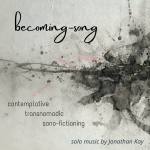 Next Post
Next Post
